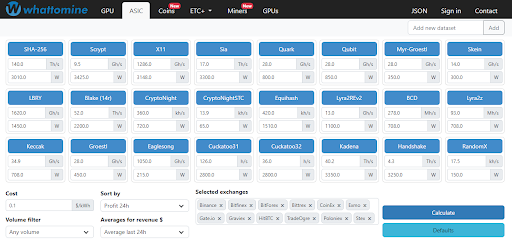How to maximize your Crypto profits ? WhatToMine Guide


If you want to know how you can maximize your crypto profits, you’ve come to the right place! With housands of altcoins available, each with different technologies, algorithms and computing power required, you may wonder how can you determine which one is the most profitable to mine. The answer is simple: WhatToMine.com, a platform that allows you calculate your crypto mining profits and we’ll explain to you how to use it!
Understanding WhatToMine
WhatToMine, first and foremost, is a comprehensive tool that crypto miners around the globe rely on for profitability calculations. Whether for novices or experts alike, the sheer abundance of cryptocurrencies available for mining can certainly be overwhelming. Interestingly, each coin uses a different algorithm, meaning that the effectiveness of your hardware can vary dramatically from one coin to another. That’s precisely where WhatToMine comes in.
This platform allows you to input your hardware’s specifics, from the number and type of GPUs or ASICs devices you’re running to the amount of power they consume. With this information, WhatToMine calculates the most profitable coin to mine based on the current state of various cryptocurrency markets.
It considers current exchange rates, block rewards, and network difficulties (which affect how much computing power is required to mine a block). The data is continuously updated, providing real-time insight and guidance for miners.
The interface of WhatToMine might be intimidating upon your first visit, given the myriad of blank lines, pre-filled dollar amounts, and crypto jargon. Yet, it becomes much easier to understand and navigate once you get accustomed to it.
The different columns on the website correspond to different mining algorithms such as Ethash, CryptoNight, Scrypt, SHA-256, etc. These algorithms are essentially the ‘math problems’ that your mining hardware needs to solve to validate transactions and earn rewards
Using WhatToMine Profit Calculators
To start using the calculator, first, choose the correct algorithm, then, enter your GPU’s hash rate and power consumption. Finally, if you wish, select relevant exchanges (Ex: Binance, Bitfinex, BitForex, CoinEx, etc.). Ab alternative option is available where you can simply input the quantity of GPUs for a particular model, and the website will then perform an automatic computation of the hash rate and power consumption.
After clicking on ‘Calculate’, the website displays a list of coins your rig can mine and their profitability. For instance, if you’re using six Nvidia GTX 1070 GPUs, the website will show the profitability for this setup.
Remember that the displayed numbers are rough estimates since network difficulty and currency exchange rates constantly change. So, it’s crucial not to bank on weekly or monthly calculations.
Using WhatToMine for ASIC Mining
ASIC (Application-Specific Integrated Circuit) miners are highly efficient devices designed for cryptocurrency mining. WhatToMine accommodates ASIC miners as well. The process remains the same; input the correct values for your ASIC miner and click ‘Calculate’.

Detailed Coin Profits
For an in-depth look at coin profitability, navigate to the ‘Coins’ section, select a coin, and enter your miner values. Detailed tables showing estimated rewards per hour, day, week, month, and year can be obtained by inputting your electricity cost per kWh and hardware cost. These results include estimated rewards in the chosen coin, BTC, and USD, with the last column showing the net profit after accounting for power costs and mining pool fees.
Understanding Hash Rate Conversion
When dealing with cryptocurrency mining, one of the most crucial factors is hash rate, which is a measure of a miner’s computational power. Essentially, the higher the hash rate, the more chances of solving the mathematical computations necessary for earning cryptocurrencies.
The hash rate can be represented in various denominations due to the vast computational power differences found within mining equipment. In ascending order, these denominations include kilohash (KH/s), megahash (MH/s), gigahash (GH/s), terahash (TH/s), petahash (PH/s), and exahash (EH/s). Each denomination is 1,000 times larger than the one before it, mirroring the metric system’s structure.
Applying Hash Rate Conversion
For the purpose of our discussion and to simplify calculations on WhatToMine, let’s focus on the first three primary denominations that you’ll often encounter: kilohash, megahash, and gigahash.
Kilohash (KH/s): A kilohash is 1,000 hashes per second. This is the smallest measurement used in cryptocurrency mining. Less powerful mining rigs, especially those in the early days of Bitcoin, worked at this level.
Megahash (MH/s): A megahash equals 1,000 kilohashes or 1,000,000 (one million) hashes per second. This hash rate level is commonly seen in many GPU mining rigs today.
Gigahash (GH/s): A gigahash equals 1,000 megahashes or 1,000,000,000 (one billion) hashes per second. It’s a prevalent measurement in powerful mining setups, such as ASIC miners.
So, to convert between these units, remember:
- 1 MH/s = 1,000 KH/s,
- 1 GH/s = 1,000 MH/s
- 1 TH/s = 1,000 GH/s.
Understanding these conversions is critical as it helps you correctly input your mining hardware’s computational power into the WhatToMine calculator. Moreover, it gives you a better grasp of the scale at which different mining equipment operates, enabling you to make better decisions about potential investments in mining hardware.
By mastering these hash rate conversions, you can use WhatToMine more effectively, making sure that the mining profitability calculations you get are as accurate as possible.
Final Thoughts
Keep in mind that WhatToMine.com is an estimate tool, and actual profits may vary. Always double-check the values before starting to mine and be aware of your electricity rates. With these guidelines, you should be well on your way to using WhatToMine to its fullest potential, helping you make informed decisions on your crypto mining journey.
If you need more help on startming your mining activities, let’s take a look to our support section, our Discord or our Telegram.